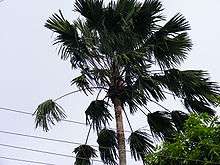Saribus rotundifolius
Saribus rotundifolius, the round-leaf fountain palm, is a palm found in Southeast Asia.[1] It is a member of the genus Saribus. It is also called footstool palm (English) and as anahaw or luyong (Filipino).[2] The foliage of the Saribus rotundifolius is the unofficial national leaf of the Philippines.[3]
| Saribus rotundifolius | |
|---|---|
 | |
| Saribus rotundifolius in Kolkata, India | |
| Scientific classification | |
| Kingdom: | Plantae |
| Clade: | Tracheophytes |
| Clade: | Angiosperms |
| Clade: | Monocots |
| Clade: | Commelinids |
| Order: | Arecales |
| Family: | Arecaceae |
| Genus: | Saribus |
| Species: | S. rotundifolius |
| Binomial name | |
| Saribus rotundifolius (Lam.) Blume | |
| Synonyms | |
| |
It is a common landscaping plant in the region. It can grow in sub-tropical climates and humid, tropical areas.[1]
This palm is an erect and solitary, and grows at a height ranging from 15-25 m and diameter thickness of about 25 cm. Its trunk is smooth and straight with a shallow rings of leaf scars.[4] The leaves are used for thatching and food wrapping. Overharvesting of leaves of wild plants have reduced leaf size. The leaves do grow faster after harvest but tend to be smaller.[1]
In September 2011, after DNA research the reclassification from the genus Livistona to the resurrected genus Saribus was official.[5]
References
- "Tropical Palms - Asian region". Food and Agriculture Organization of the United Nations. Retrieved 2007-01-19.
- Marcial C. Amaro Jr., ed. (January–April 2010). "Anahaw" (PDF). Some Familiar Philippine Palms that Produce High Food Value and Tikog. Ecosystems Research and Development Bureau of the Philippine Department of Environment and Natural Resources. Archived from the original (PDF) on 2013-05-22. Retrieved 2013-04-01.
- Pangilinan, Jr., Leon (3 October 2014). "In Focus: 9 Facts You May Not Know About Philippine National Symbols". National Commission for Culture and the Arts. Retrieved 8 January 2019.
- Razal, Ramon; Palijon, Armando (2009). Non-Wood Forest Products of the Philippines. Calamba City, Laguna: El Guapo Printing Press. p. 27. ISBN 978-971-579-058-1.
- "New genus, SARIBUS, is resurrected". PalmTalk.org. Retrieved 2012-01-13.